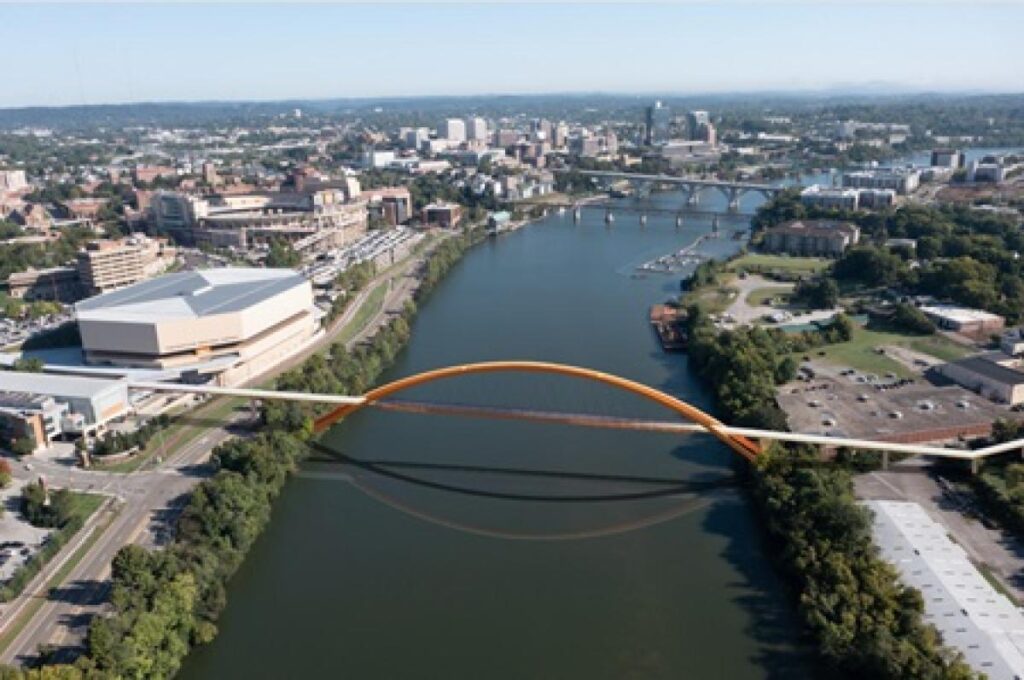Wed March 20, 2024 – Southeast Edition
Rendering courtesy of the City of Knoxville
Development of a pedestrian-bicycle bridge will connect the University of Tennessee Campus with the South Knoxville Waterfront Redevelopment Area.
The proposed South Waterfront Pedestrian Bridge in Knoxville, Tenn., could be one step closer to becoming reality now that Mayor Indya Kincannon has applied for $25 million in federal funds to take it to the finish line, the Knoxville News Sentinel reported March 18.
It is the city’s second attempt at applying for federal funds through the Rebuilding American Infrastructure with Sustainability and Equity (RAISE) grant, but municipal officials are confident a new and less expensive design will go their way this time.
“We feel like we have a much more competitive application for this year,” Rebekah Jane Justice, Knoxville’s chief of urban design, told the newspaper.
Last September, the city accepted $20 million in Tennessee Department of Transportation (TDOT) funds specifically earmarked for building the $60 million bridge. It also hired an engineering consulting firm to improve the structure’s design.
It has been a long time coming.
Kincannon hopes to increase connectivity between neighborhoods during her second term, but the origins of the project date back to the 2006 South Waterfront Vision Plan, which aimed to address historic isolation and under-investment in South Knoxville communities. The bridge is a central part of connecting South Knoxville to the main campus of the University of Tennessee (UT) and Fort Sanders.
It also would provide equitable access and affordable transportation options to and from South Knoxville. Currently, the only alternative to driving to the area is walking or biking on existing highways and bridges, which have traffic counts of more than 32,500 vehicles per day, the RAISE application noted.
Plans call for the pedestrian bridge to span the Tennessee River from Clancy Avenue on the south side to the pedestrian concourse on the north, between Thompson-Boling Arena at Food City Center and Pratt Pavilion.
Once open, the crossing will expand the pedestrian-bicycle network connecting 18 mi. of greenways throughout Knoxville.
In a related effort, the city recently received $42.6 million from another federal grant to create more paths connecting East Knoxville residents to downtown, and downtown to South Knoxville’s Urban Wilderness.
“[The bridge] is an opportunity to redevelop industrial property while providing sustainable and economic development linkage between the South Waterfront, the [university], downtown Knoxville and the expanding greenway system,” according to the city’s project webpage.
Since 2009, substantial work has been accomplished on identifying the bridge’s location, initial structural plans, an infrastructure needs analysis and securing approvals from various state, federal and environmental agencies.
In addition, the river crossing will employ an iconic design element that also complements UT’s campus and the city’s downtown skyline.
Before construction can begin, the pedestrian bridge designs must meet the required vertical clearance over the river’s barge channel, the Gulf & Ohio rail line and Neyland Drive.
Bridge to Benefit Both Knoxville, UT Campus
Knoxville officials noted the connectivity of the pedestrian-bicycle bridge also should help support UT’s strategic plan to significantly expand its student and faculty population over the next several years as access to housing continues to be a growing concern.
In March 2022, the university’s Board of Trustees agreed to expand the official campus boundaries by adding a small bit of land on the south bank of the Tennessee River. While that boundary extension does not mean the plan will become a reality, it allows discussions to continue.
Additionally, building the pedestrian bridge, a key element of the South Waterfront Vision Plan, will likely accelerate private investments in the area.
“This is an opportunity to redevelop historical industrial property while providing sustainable and economic development linkage between the South Waterfront, UT, downtown Knoxville and the expanding greenway system,” according to the city’s online project page.
City officials also made it clear to the News Sentinel that the $60 million project will not plunge Knoxville into debt. Aside from $15 million in tax increment financing from the city’s Community Development Corp., most of the money for the bridge would come from state and federal sources, like the RAISE grant.
Justice said the bridge will pay for itself through an anticipated increase in property tax revenues that come with new investments as a result of the new structure.
CDM Smith, the Knoxville-based engineering firm hired for the project, was able to cut costs by $10 million since the city last applied for federal funds by planning to use materials that do not need to be painted during the bridge’s construction or use; by doing so, expensive painting and cleaning products are eliminated, according to the grant application.
Read the full article here











